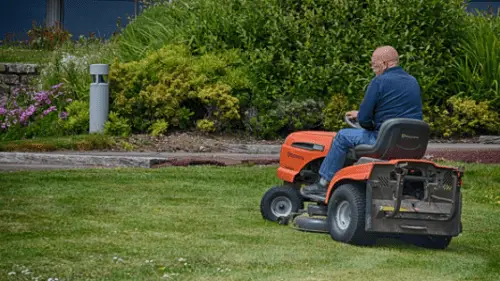Finding the right size lawn mower is important because it can prevent a lot of hassle down the road. A lawn mower that is too big for a yard may be difficult to maneuver and lead to unnecessary expenses that come with maintaining a larger mower. A lawn mower that is too small will create an exhausting and frustrating chore each time the lawn is mowed.
Let’s take a look at some ways to determine the right size lawn mower for your yard
Table of Contents
Lawn Size and Mower Size
Lawn size is often the best gauge to determine what size lawn mower you need for your yard. The below information reflects some general guidelines for selecting a lawn mower based on the size of your lawn using acre(s). For reference, the football field image below provides a good visual of the size of an acre.
Image: Jc3s5h via Wikipedia
1/4 acre or less – A lawn mower for a small yard can include a reel mower, electric/battery mower, push mower, or a self-propelled mower. These type of lawn mowers will have cutting widths ranging from about 15 to 21 inches.
1/4 acre to 1/2 acre – This is the lawn size where a self-propelled lawn mower starts to make sense. Most people prefer not to use a manual or push mower on this lawn size because of the physical labor that is required to complete the mow. This is especially true for lawns at or near 1/2 acre. The common cutting width of a walk-behind self-propelled mower is 21 inches.
1/2 acre to 1.5 acres – You can start thinking about a riding mower over 1/2 acre. The 42 inch riding mowers tend to be popular for this acreage range. Expect to pay over $1,000 for a new high-quality mower.
Over 1.5 acres – Again, you will want a riding mower, but potentially with a larger cutting width than 42 inches. There are several mowers, including zero turn mowers, that have cutting widths from 46 inches to 60 inches. Of course, the larger the cutting width, the faster the job will get done.
Other Factors
While lawn size often determines the size of lawn mower, other factors can come into play where lawn size is not so relevant. For example, someone that has difficulty moving around to complete yard maintenance may opt for a riding mower even for a small yard. Something like the Troy-Bilt 30-Inch Premium Neighborhood Riding Mower is a smaller riding mower that can be used in many residential yards because it lacks the bulk of many larger mowers.
On the other extreme, their are people who use mowing as exercise and will mow their large lawn with a walk-behind mower. We give these people a lot of respect. Additionally, for many people it may be a money issue. Riding mowers, even used, can be pricey. People that are frugal, on a budget, or for various other financial reasons may choose to use a less expensive walk-behind mower on a large lawn even though it might not be the most practical option.
Features
The following main features are often considered by buyers before selecting a
lawn mower.
Electric Start – With a push of a button or turn of a key, the lawn mower starts right up without the hassle of pulling a cord.
Mulching – If your lawn mower if equipped with mulching capabilities, the blade will cut the grass into tiny pieces that will fall back into the lawn. The mulched pieces of grass are so small that they will not be noticed in the lawn. Mulching is beneficial because it adds essential nutrients to the soil such as nitrogen, phosphorus, and potassium.
Bagging – A bagging feature is convenient for picking up leaves or debris. Furthermore, it is a great option to have for mowing extremely long grass that does not mulch well.
AWD, RWD, or FWD – Self-propelled lawn mowers come with the option of all-wheel, rear-wheel, or front-wheel drive. FWD mowers are best for flat lawns whereas AWD and RWD mowers are ideal for uneven or hilly terrain.
Transmission – The typical transmissions for riding mowers are manual, automatic, and hydrostatic. A manual transmission uses a lever to switch from different speeds and to go in reverse. An automatic transmission drives like a car where a pedal controls the speed and a brake slows the mower down. Lastly, a hydrostatic system uses a hydraulic pump system along with a hydraulic motor to operate the machine.


